Scientists see Wadden Sea at serious risk due to climate change
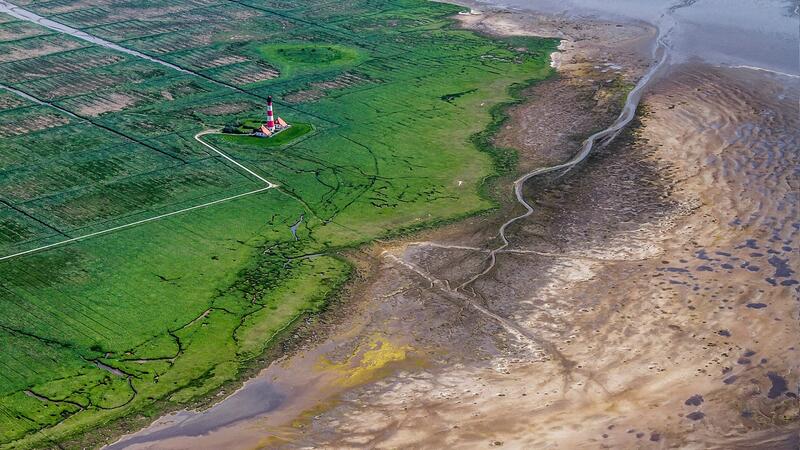
From 30.11. to 2.12.2021 more than 200 scientists from Denmark, Germany and the Netherlands presented and discussed the latest scientific findings on the status of the UNESCO World Heritage Wadden Sea at the 15th International Scientific Wadden Sea Symposium (ISWSS). The event was originally planned as a face-to-face meeting in Büsum, Germany, but now took place online.
Climate change and the associated sea level rise are considered among the greatest threats to the globally unique ecosystem of the Wadden Sea. Their impact on the biodiversity and geological dynamics of the Wadden Sea as well as possible protection measures were the focus of the symposium. In six separate sessions, the participants explored the impact of climate change.
The key topics were Birds, Marine Mammals, Alien Species, Sublittoral Habitats, and Socioeconomic/Ecological Sustainable Development. In addition to various presentations on the latest research results, recommendations for the management of the Wadden Sea and further research needs were discussed and formulated by the expert groups on each topic.
The symposium also looked beyond its own protected area and featured international World Heritage experts as well as guest speakers from the Korean Getbol wetlands, which was designated a World Heritage Site this summer.
“International cooperation is of great importance for the protection of marine natural world heritage sites, as they are particularly endangered by climate change. The Trilateral Wadden Sea Cooperation makes an important contribution to the protection of these sensitive ecosystems and for this is recognised worldwide,” says Ilka Wagner, Head of the Marine Nature Conservation Division at the German Federal Environmental Ministry.
“Persistently high numbers of new species in the Wadden Sea and their successful establishment show how human factors can interact,” said Dr. Christian Buschbaum, marine ecologist at the Alfred Wegener Institute on Sylt, who moderated the session on alien species. “With global shipping foreign organism species are being introduced. Due to climate warming they find good living conditions in the Wadden Sea. What effects these exotics have on the ecosystem is a central topic of research. Developing measures to protect the Wadden Sea from further spreads of new species is an increasingly important international task.“
At the end of the three-day meeting, the Chair of the Wadden Sea Board, the highest operating body of the Trilateral Wadden Sea Cooperation, summarized the findings of the symposium: “Science shows that the Wadden Sea World Heritage Site is already significantly affected by climate change impacts. The symposium particularly emphasized the need to further intensify the exchange of data and information between the three countries to be able to adapt the management for the protection of the Wadden Sea to new challenges,” said Prof. Dr. Karin Lochte.
The results from the scientific discussions will provide the basis for the Ministerial Declaration of the next Trilateral Governmental Conference of the three Wadden Sea countries. The conference sets the political course for the protection of the Wadden Sea in the coming years and will take place in Wilhelmshaven at the end of 2022 at the invitation of the German government, marking the end of its presidency of the Trilateral Wadden Sea Cooperation. The scientific results will also be published under “Biodiversity and Ecology of the Wadden Sea under changing environments” in the journal “Marine Biodiversity”.
"With more than 200 international participants, the virtual symposium was very well received. Thanks to the multifunctional platform, the collegial exchange online also worked out great,” Marina Sanns from the National Park Authority “Schleswig-Holsteinisches Wattenmeer”, who was instrumental in organizing the symposium, is pleased to say. “This was a great conclusion to this year’s National Park theme “Science in the Wadden Sea – uncovering the hidden”.
The 15th ISWSS was organized by the National Park Authority “Schleswig-Holsteinisches Wattenmeer” in cooperation with the German Federal Environmental Ministry and the Common Wadden Sea Secretariat (CWSS). In the framework of the Trilateral Cooperation for the Protection of the Wadden Sea, this event is regularly held one year before the end of the presidential term of one of the three Wadden Sea states. The previous scientific symposium was held in Tønder, Denmark, in 2017.
>> Symposium Report
A visual take on ISWSS15
Science illustrator and researcher Jagoba Malumbres-Olarte listen in to the thematic sessions of the symposium. Below he explains his illustrations.
Overall illustration
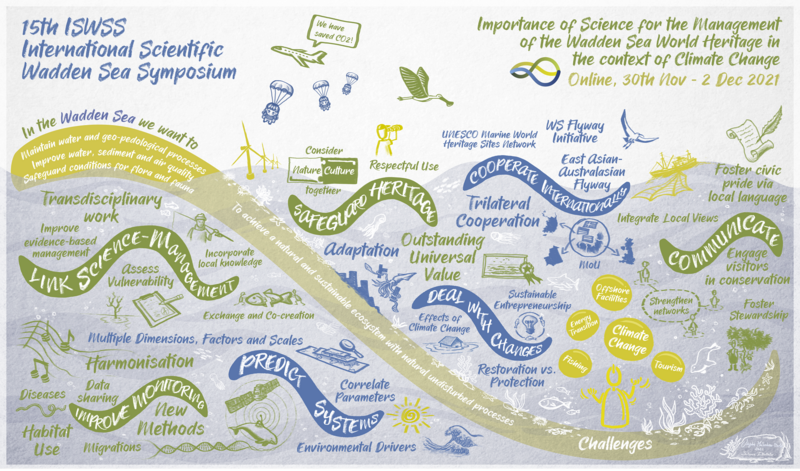
The overall illustration of the symposium highlights some of the main discussions as well as the general character of the event, starting with the fact that it had to be moved online at last minute - saving CO2 from the cancelled travel plans. With the Trilateral Wadden Sea Cooperation's Guiding Principle running through the image, its main challenges are shown in balls, needing to be juggled at the same time. Calls for action include safeguarding the Wadden Sea World Heritage, coorperating internationally, dealing with changes, linking science and management, improving monitoring, trying to predict the system and communicating the Wadden Sea.
Alien Species
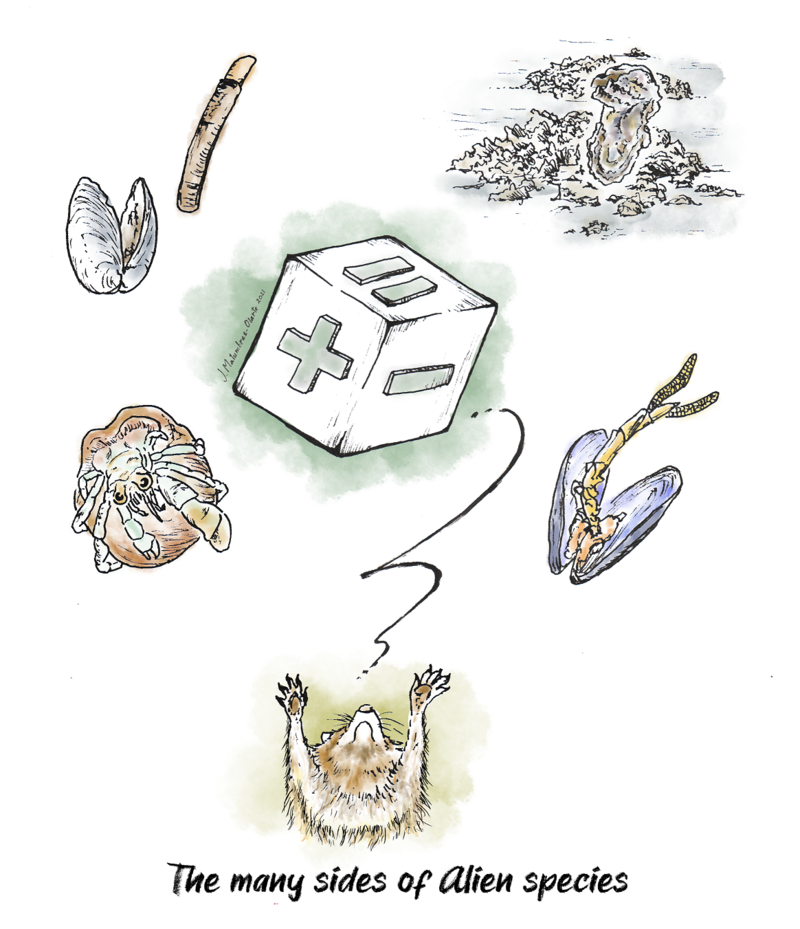
The image shown here symbolises the current debate about alien (exotic, non-native) species in the Wadden Sea: how alien species should be treated in the Wadden Sea. As discussed in the alien species session during the Symposium, these species may have positive, negative or no effects (shown on the different sides of the die) for local biodiversity and society: the saltwater clam Ruditapes phlippinarum and razor clam Ensis leei (top left); the habitat changing oyster Magallana gigas (top right); the intestinal copepod parasite of bivalves Mytilicola orientalis, (illustrated with a native blue mussel, bottom right); the hermit crab Diogenes pugilator (bottom left); and the racoon dog (bottom).
Marine Mammals

This image resumes the research subjects of the seminars presented in the marine mammal session of the Symposium: the species monitoring using telemetry; the (intertidal) habitats used and needed by the different species; the effects of anthropogenic activities (e.g. through noise); and the impact of diseases on the reproduction and population demographics. All these factors must be considered for the management of marine mammals in the Wadden Sea.
Birds
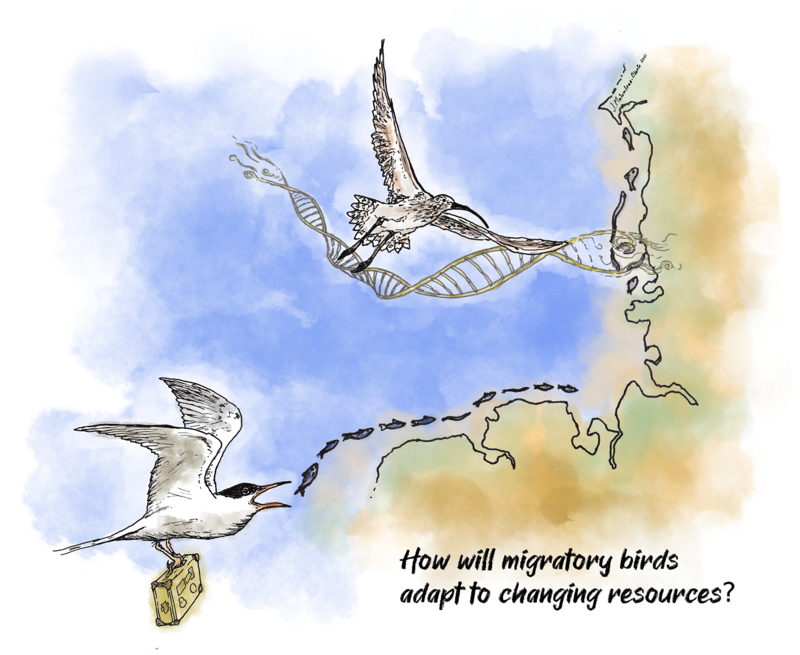
The birds in this image represent the migration through he Wadden Sea that may be determined by the resources available in the area (the tern with the suitcase and the fish-looking islands) and the genetic trigger in each species (Numenius arquata and the DNA helix).
Sublittoral Habitats

This image shows the mapping of sublittoral habitats by a research vessel using scan sonars and the four current features of/initiatives in these habitats in the Wadden Sea: the invasion of Ensis leei and Magallana gigas (bottom); the evaluation surveys on native Mytilus edulis musselbeds (second from the bottom); the restoration of Zostera seagrass (third from the bottom); and the decline of reef-forming Sabellaria spinulosa worms. The upwards direction of the sea represents the rise in the sea level.
Sustainable Development - Ecology
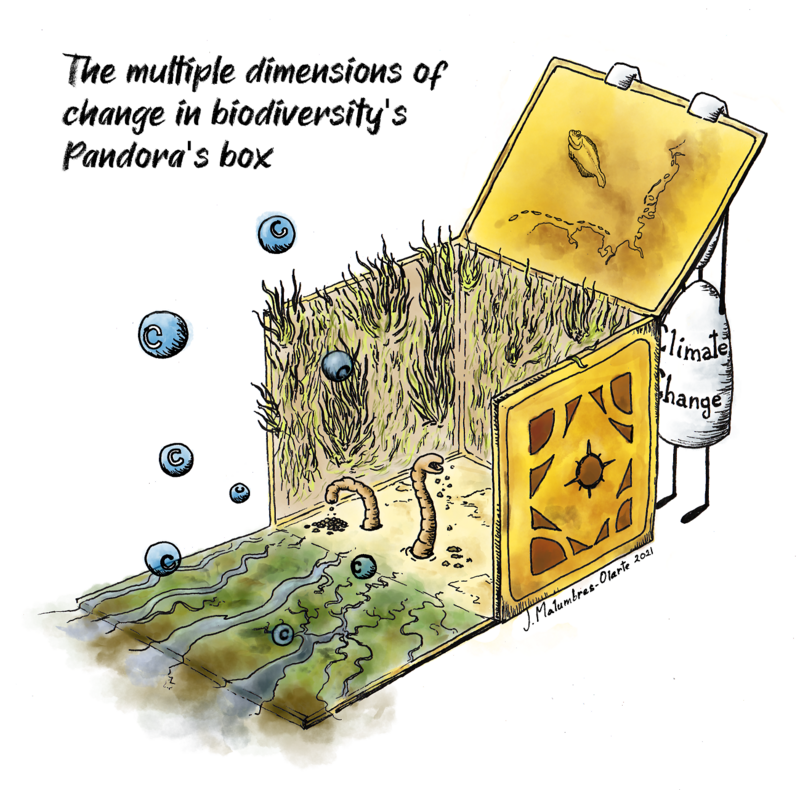
The image shows the “Pandora’s Box” of the measurement of biodiversity change (in multiple dimensions), which could assist us understand the drivers behind it, necessary for ecosystem status assessments in the face of climate change. These measurements and assessments may show how the recovery of seegrass habitats may be achieved and what effects climate change may have on the carbon sequestrated in salt marshes. The worms represent the effects of bioturbation on sediments (not fully understand) and the map of the Wadden Sea on the side of the box is a hint on the effects of climate change on the phenology (migration patterns) of certain species like the plaice.
Sustainable Development - Social-Cultural
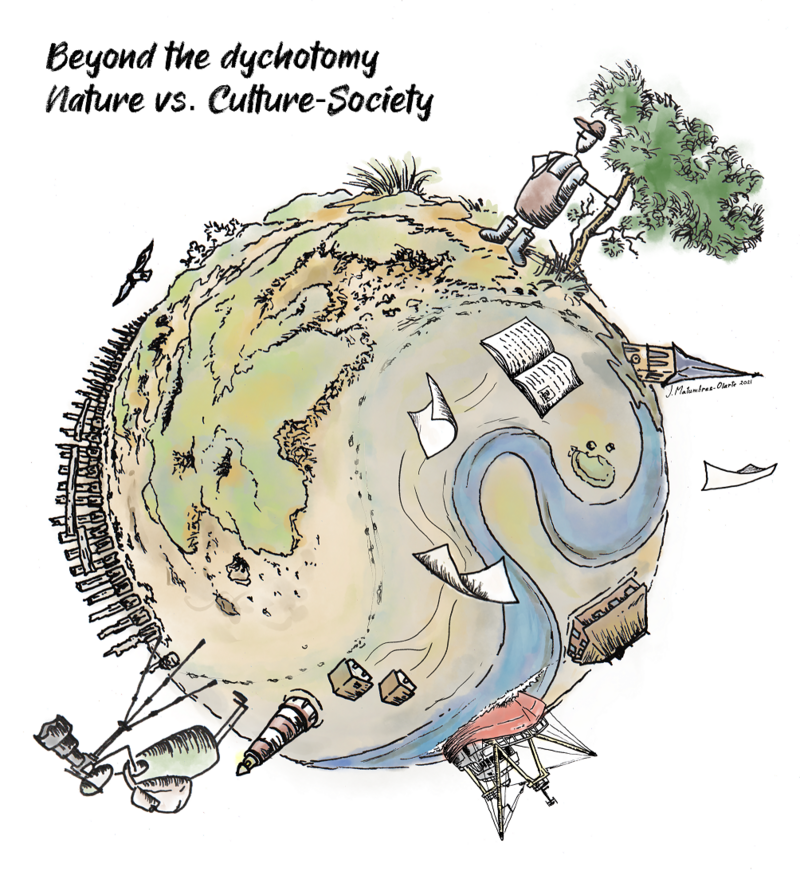
The sphere in this image is based on the classic ying-yang symbol and represents the dichotomy between nature (left) and culture-society (right). This separation is not often (and should not be) clear, like in the case of the tourists that enjoy nature (bottom left). Also, the locals (top right) usually develop a mixture motion of both (by seeing them as part of the same landscape) and a sense of stewardship (hence her/his holding the tree). The book and the flying pages represent the role of literature in understanding and achieving sustainable development. The sunken church tower represents the flooded towns in Frisian marshands and the interactions between nature and human landscapes.
International Perspectives

The two birds (Calidris canutus and Mergus squamatus) represent, at the same time, two migratory flyways (East Atlantic and Australasian, respectively) and the research and management groups that work in different parts of the world. These groups (the birds) may collaborate with each other (sharing knowledge, experience, assessment tools and actions) to develop better sustainable development strategies, and to better protect and manage coastal habitats and the related heritage. These actions may include the restoration of coastal habitats (represented in the illustration by reefs formed by Sabellaria spinulosa worms), as a strategy to adapt to climate change (represented by the orange dawn) and the rise of the sea level (represented by the rising hand).
